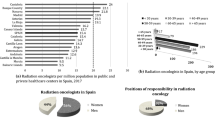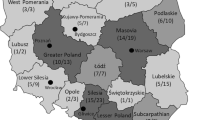Abstract
It was the aim of this work to assess and track the workload, working conditions and professional recognition of radiation oncology medical physicists (ROMPs) in the Asia Pacific region over time. In this third survey since 2008, a structured questionnaire was mailed in 2014 to 22 senior medical physicists representing 23 countries. As in previous surveys the questionnaire covered seven themes: 1 education, training and professional certification, 2 staffing, 3 typical tasks, 4 professional organisations, 5 resources, 6 research and teaching, and 7 job satisfaction. The response rate of 100 % is a result of performing a survey through a network, which allows easy follow-up. The replies cover 4841 ROMPs in 23 countries. Compared to 2008, the number of medical physicists in many countries has doubled. However, the number of experienced ROMPs compared to the overall workforce is still small, especially in low and middle income countries. The increase in staff is matched by a similar increase in the number of treatment units over the years. Furthermore, the number of countries using complex techniques (IMRT, IGRT) or installing high end equipment (tomotherapy, robotic linear accelerators) is increasing. Overall, ROMPs still feel generally overworked and the professional recognition, while varying widely, appears to be improving only slightly. Radiation oncology medical physics practice has not changed significantly over the last 6 years in the Asia Pacific Region even if the number of physicists and the number and complexity of treatment techniques and technologies have increased dramatically.


Similar content being viewed by others
References
Round WH, Jafari S, Kron T, Azhari HA, Chhom S, Hu YM, Mauldon GF, Cheung KY, Kuppusamy T, Pawiro SA, Lubis LE, Soejoko DS, Haryanto F, Endo M, Han Y, Suh TS, Ng KH, Luvsan-Ish A, Maung SO, Chaurasia PP, Jafri MA, Farrukh S, Peralta A, Toh HJ, Shiau AC, Krisanachinda A, Suriyapee S, Vinijsorn S, Nguyen TC (2015) Brief histories of medical physics in Asia-Oceania. Australas Phys Eng Sci Med. doi:10.1007/s13246-015-0342-9
Kron T, Azhari H, Voon E, Cheung K, Ravindran P, Soejoko D, Inamura K, Han Y, Ung N, Bold L, Win U, Srivastava R, Meyer J, Farrukh S, Rodriguez L, Kuo M, Lee J, Kumara A, Lee C, Krisanachinda A, Nguyen X, Ng K (2012) Medical physics aspects of cancer care in the Asia Pacific region: 2011 survey results. Biomed Imaging Interv J 8:e10. doi:10.2349/biij.8.2.e10
Kron T, Cheung K, Dai J, Ravindran P, Soejoko D, Inamura K, Song J, Bold L, Srivastava R, Rodriguez L, Wong T, Kumara A, Lee C, Krisanachinda A, Nguyen X, Ng K (2008) Medical physics aspects of cancer care in the Asia Pacific region. Biomed Imaging Interv J 4:e33. doi:10.2349/biij.4.3.e33
IAEA (2008) Setting up a radiotherapy programme STI/PUP 1296. International Atomic Energy Agency, Vienna
IAEA (2009) Clinical training of medical physicsts specializing in radiation oncology. International Atomic Energy Agency, Vienna
Stefanoyiannis AP, Christofides S, Psichis K, Geoghegan DS, Gerogiannis I, Round WH, Geronikola-Trapali X, Armeniakos I, Kaplanis PA, Prentakis A, Chatziioannou SN (2012) The education and training of clinical medical physicists in 25 European, 2 North American and 2 Australasian countries: similarities and differences. Phys Med 28:183–190. doi:10.1016/j.ejmp.2011.07.001
Eudaldo T, Olsen K (2010) The European Federation of Organisations for Medical Physics. Policy Statement No. 12: the present status of medical physics education and training in Europe. New perspectives and EFOMP recommendations. Phys Med 26:1–5. doi:10.1016/j.ejmp.2009.02.005
Eudaldo T, Olsen K (2008) The present status of medical physics education and training in Europe: an EFOMP survey. Phys Med 24:3–20. doi:10.1016/j.ejmp.2007.09.022
Kron T (2008) Imaging in the radiotherapy treatment room. J Med Imaging Radiat Oncol 52:99–100. doi:10.1111/j.1440-1673.2007.01922.x
Ng KH, Cheung KY, Hu YM, Inamura K, Kim HJ, Krisanachinda A, Leung J, Pradhan AS, Round H, van Doomo T, Wong TJ, Yi BY (2009) The role, responsibilities and status of the clinical medical physicist in AFOMP. Australas Phys Eng Sci Med 32:175–179
Round WH, Ng KH, Healy B, Rodriguez L, Thayalan K, Tang F, Fukuda S, Srivastava R, Krisanachinda A, Shiau AC, Deng X, Han Y (2011) AFOMP Policy Statement No. 3: recommendations for the education and training of medical physicists in AFOMP countries. Australas Phys Eng Sci Med 34:303–307. doi:10.1007/s13246-011-0091-3
Round WH, Ng KH, Healy B, Rodriguez L, Thayalan K, Tang F, Fukuda S, Srivastava R, Krisanachinda A, Shiau AC, Deng X, Han Y (2012) AFOMP policy statement no. 4: recommendations for continuing professional development systems for medical physicists in AFOMP countries. Australas Phys Eng Sci Med 35:393–397. doi:10.1007/s13246-012-0163-z
Round WH, Tay YK, Ng KH, Cheung KY, Fukuda S, Han Y, Huang YX, Kim HJ, Krisanachinda A, Liu HL, Asia-Oceania Federation of Organizations for Medical P (2010) AFOMP POLICY STATEMENT No. 2: recommended clinical radiation oncology medical physicist staffing levels in AFOMP countries. Australas Phys Eng Sci Med 33:7–10. doi:10.1007/s13246-010-0003-y
Round WH, Stefanoyiannis AP, Ng KH, Rodriguez LV, Thayalan K, Han Y, Tang F, Fukuda S, Srivastava R, Krisanachinda A, Shiau AC, Deng X (2015) AFOMP Policy No 5: career progression for clinical medical physicists in AFOMP countries. Australas Phys Eng Sci Med 38:217–221. doi:10.1007/s13246-015-0355-4
Acknowledgments
The material has been presented in parts at the World Congress for Medical Physics and Biomedical Engineering, Toronto, 2015.
Author information
Authors and Affiliations
Corresponding author
Rights and permissions
About this article
Cite this article
Kron, T., Azhari, H.A., Voon, E.O. et al. Medical physics aspects of cancer care in the Asia Pacific region: 2014 survey results. Australas Phys Eng Sci Med 38, 493–501 (2015). https://doi.org/10.1007/s13246-015-0373-2
Received:
Accepted:
Published:
Issue Date:
DOI: https://doi.org/10.1007/s13246-015-0373-2




